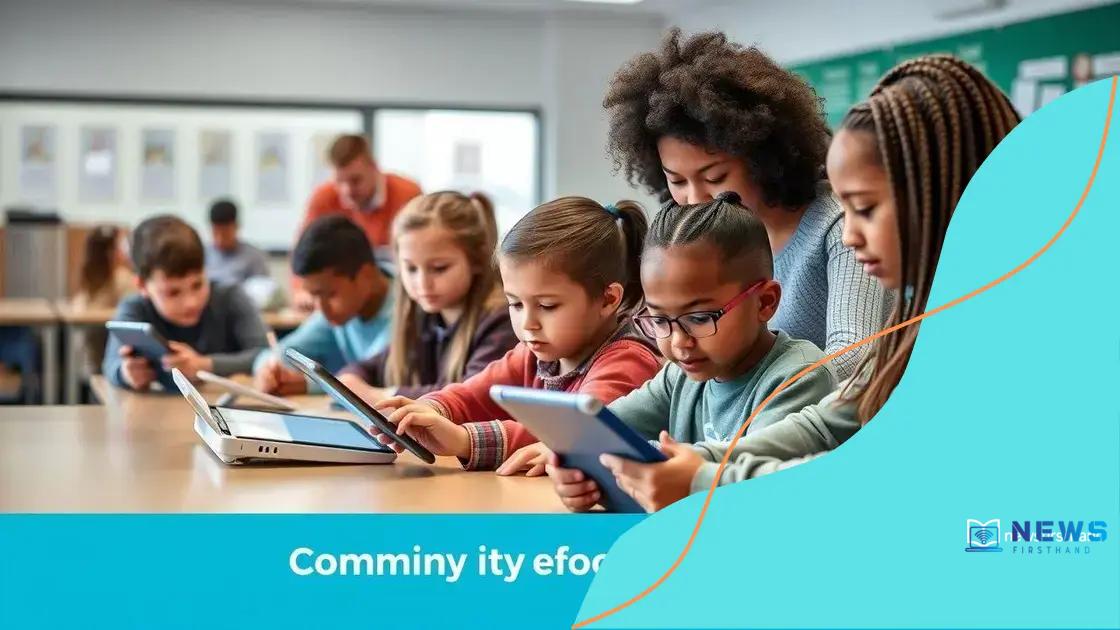Urban education access improvement: a pressing challenge

Urban education access improvement requires addressing barriers, fostering community involvement, implementing innovative solutions, and advocating for policy changes to ensure equitable learning opportunities for all students.
Urban education access improvement is crucial for creating equal opportunities in our cities. Have you ever wondered how these disparities impact our communities? Let’s dive in and explore what can be done.
Understanding urban education challenges
Understanding the urban education challenges is crucial for improving access in cities. Urban areas often face unique barriers that can hinder students’ ability to succeed. From lack of resources to systemic inequities, it’s vital to address these issues.
Key Barriers to Education
There are several factors that contribute to the challenges in urban education. These include:
- Inadequate funding for schools
- High teacher turnover rates
- Lack of access to technology and resources
- Socioeconomic disparities among students
These barriers can create an environment where students struggle to perform academically. Moreover, the impact goes beyond individual students, affecting entire communities.
Impact of Socioeconomic Status
The socioeconomic status of families plays a significant role in education. Families with lower incomes often face challenges such as housing instability and limited access to health care. These adverse conditions can lead to stress, which negatively affects children’s learning.
In urban settings, many students come from backgrounds that experience multiple layers of hardship. When schools lack the resources to address these challenges, students may not reach their full potential.
Another aspect is the need for additional support systems. Wraparound services that provide mental health support, tutoring, and family engagement can be essential. Schools that implement these services tend to see better outcomes.
Community Engagement
Engaging the community is crucial for addressing urban education challenges. When families and local organizations work together, they can create a supportive environment for students. This collaboration can lead to:
- Increased parental involvement in schools
- Partnerships for mentorship programs
- Resource sharing among schools and local agencies
- Advocacy for policy changes that benefit education
By fostering strong connections between schools and the community, we can help to overcome the barriers that exist.
The road to improving urban education may be complex, but understanding these challenges is the first step in creating actionable solutions. Through dedicated efforts, communities can work towards ensuring that all students have the opportunity to succeed.
Barriers to education access in cities
Barriers to education access in cities are significant obstacles that many students face. Understanding these barriers is essential to addressing the needs of urban students. These challenges can vary widely and often intersect, creating complex issues that hinder educational success.
Common Barriers
Some of the most common barriers include:
- Insufficient funding: Many urban schools operate with limited budgets, affecting resources and staffing.
- Large class sizes: Overcrowded classrooms can make it hard for teachers to provide the individualized attention students need.
- Transportation challenges: Students may live far from schools, making it difficult to attend regularly.
- Language barriers: Non-English speaking families often struggle to navigate the education system, leading to less engagement.
These barriers contribute to lower achievement levels among students. For example, if students do not have access to necessary materials or support, their ability to learn effectively diminishes.
Impact of Community Factors
Community factors also play a vital role in education access. In urban areas, factors such as poverty and crime rates can affect children’s education. Frequent disruptions in their home life can hinder their focus and ability to succeed in school. Students from low-income backgrounds may also have limited access to technology, reducing their chances to complete homework or engage in online learning.
Schools in these areas often struggle to attract and retain qualified teachers. When educators leave for better opportunities, it creates instability that affects students. Additionally, parents working multiple jobs may not have time to support their children’s learning, causing disengagement.
Addressing these barriers requires a multifaceted approach. Schools, communities, and policymakers must collaborate to find solutions tailored to specific local needs. Initiatives that promote mental health support, after-school programs, and family resources can provide necessary aid.
Possible Solutions
Some potential solutions include:
- Increasing funding: Advocating for more funding can help improve resources for schools.
- Transportation assistance: Providing bus services or vouchers can help students get to school more easily.
- Parent engagement programs: Programs that involve parents can help bridge the gap between home and school.
- Community partnerships: Collaborating with local businesses can create mentorship opportunities for students.
By focusing on these solutions, communities can work towards removing the obstacles that urban students face.
Innovative solutions for improving access

Innovative solutions for improving access to education in urban areas are essential for bridging the gap in educational opportunities. With various challenges facing students, creative approaches can enhance access and support learning.
Technology Integration
One of the most effective solutions is the integration of technology in education. Schools can use digital tools to provide students with resources that they may not otherwise have access to.
- Online learning platforms: These allow students to learn at their own pace, accessing materials anytime and anywhere.
- Virtual tutoring: Students can receive help from tutors remotely, which can improve understanding and grades.
- Interactive learning apps: These can make learning more engaging and fun, keeping students motivated.
Using technology not only supports individualized learning but also helps students develop essential digital skills for their future careers.
Community Partnerships
Building partnerships with local organizations can also enhance educational access. Collaboration between schools and community groups can provide a wider range of resources and support.
For example, local businesses can offer internships or apprenticeship programs. These programs give students real-world experience and opportunities to develop their skills.
Moreover, community centers can host after-school programs that provide homework help and enrichment activities. These programs can be especially valuable for students from low-income families, who may not have adequate support at home.
Policy Changes
Another essential aspect is advocating for policy changes that prioritize education funding and resources. Effective policies can lead to:
- Increased funding: More financial resources can improve school facilities and teacher salaries.
- Equitable allocation of resources: Ensuring that all schools receive adequate resources, regardless of location, is crucial.
- Support for mental health services: Students need access to mental health resources to cope with stress and challenges.
Advocacy for these changes often requires collaboration between parents, educators, and community leaders, highlighting the need for collective efforts to improve educational access.
Integrating technology, partnering with the community, and pushing for policy reforms can create a more supportive educational environment. Together, these innovative solutions can make a significant impact on urban education access.
Community involvement in education
Community involvement in education plays a crucial role in enhancing students’ learning experiences. When communities come together to support schools, it creates a stronger foundation for student success. Engaged communities can provide resources, mentorship, and a sense of belonging for students.
Benefits of Community Involvement
There are many benefits to fostering community involvement. For instance:
- Enhanced resources: Local businesses and organizations can donate supplies or funding to schools.
- Increased support: Mentorship programs can connect students with role models, providing guidance and encouragement.
- Stronger relationships: Close ties between schools and communities can lead to better communication and support for families.
A strong community presence can help students feel valued and understood, which often leads to improved academic performance.
Ways to Encourage Participation
Encouraging community involvement requires deliberate efforts from schools and local organizations. Some effective strategies include:
- Organizing events: Hosting community events, like school fairs or open houses, can attract parents and residents.
- Creating volunteer opportunities: Schools can create chances for community members to volunteer, whether in classrooms or at events.
- Partnering with local organizations: Collaborations with nonprofits can help bring additional resources and volunteers into schools.
These strategies can foster a positive relationship between schools and the community, making education a shared priority.
When schools actively engage with the community, it creates a support system where students can thrive. Parents and community members who feel connected to the school are more likely to support their children’s education at home.
Examples of Successful Initiatives
Various programs across the country illustrate the power of community involvement. For example:
- Mentorship programs: Many schools have successfully implemented mentorship initiatives that pair students with local professionals.
- After-school programs: Community centers often host after-school activities that provide homework help and enrichment.
- Fundraising efforts: Schools that partner with local businesses for fundraising can significantly boost their extracurricular programs.
Such initiatives demonstrate how working together can help overcome challenges and improve educational outcomes for all students.
Policy changes to enhance educational equity
Policy changes to enhance educational equity are vital for creating fair opportunities for all students in urban areas. These changes can help level the playing field, ensuring that every child has access to quality education, regardless of their background.
Importance of Educational Equity
Educational equity ensures that all students receive the necessary supports to succeed. This involves providing resources tailored to the needs of different schools and communities. For instance, schools in low-income areas often require additional funding to offer the same level of education as those in wealthier neighborhoods.
- Access to resources: Policy changes should direct more funding to under-resourced schools, helping them obtain necessary materials.
- Addressing disparities: Data-driven policies can target areas where students struggle the most, creating programs that address specific challenges.
- Inclusion initiatives: Policies that promote inclusive classrooms can ensure that all students, including those with disabilities, have access to education.
These measures can create a more equitable learning environment where all students can thrive.
Examples of Effective Policies
Effective policies have already shown positive outcomes in various states. Some examples include:
- Weighted funding formulas: These formulas allocate more funding for students from disadvantaged backgrounds.
- Universal pre-K programs: Offering early education to all children helps set a solid foundation for future learning.
- Teacher training initiatives: Programs that focus on training educators to work in diverse classrooms can improve educational outcomes.
Such policies not only improve access but also enhance the quality of education provided to all children.
Moreover, collaboration among stakeholders is essential for implementing effective policy changes. Educators, parents, and community leaders should work together to advocate for policies that prioritize equitable education. Initiatives that promote dialogue and collaboration can lead to meaningful changes that benefit students and communities alike.
FAQ – Frequently Asked Questions about Urban Education Access Improvement
What are some common barriers to education access in urban areas?
Common barriers include insufficient funding, large class sizes, transportation challenges, and language barriers.
How can community involvement help improve education access?
Community involvement can provide additional resources, mentorship opportunities, and strengthen relationships between schools and families.
What innovative solutions can enhance urban education?
Innovative solutions include integrating technology in learning, creating community partnerships, and advocating for equitable policies.
Why are policy changes important for educational equity?
Policy changes are essential to allocate resources effectively, address disparities, and ensure all students have access to quality education.





